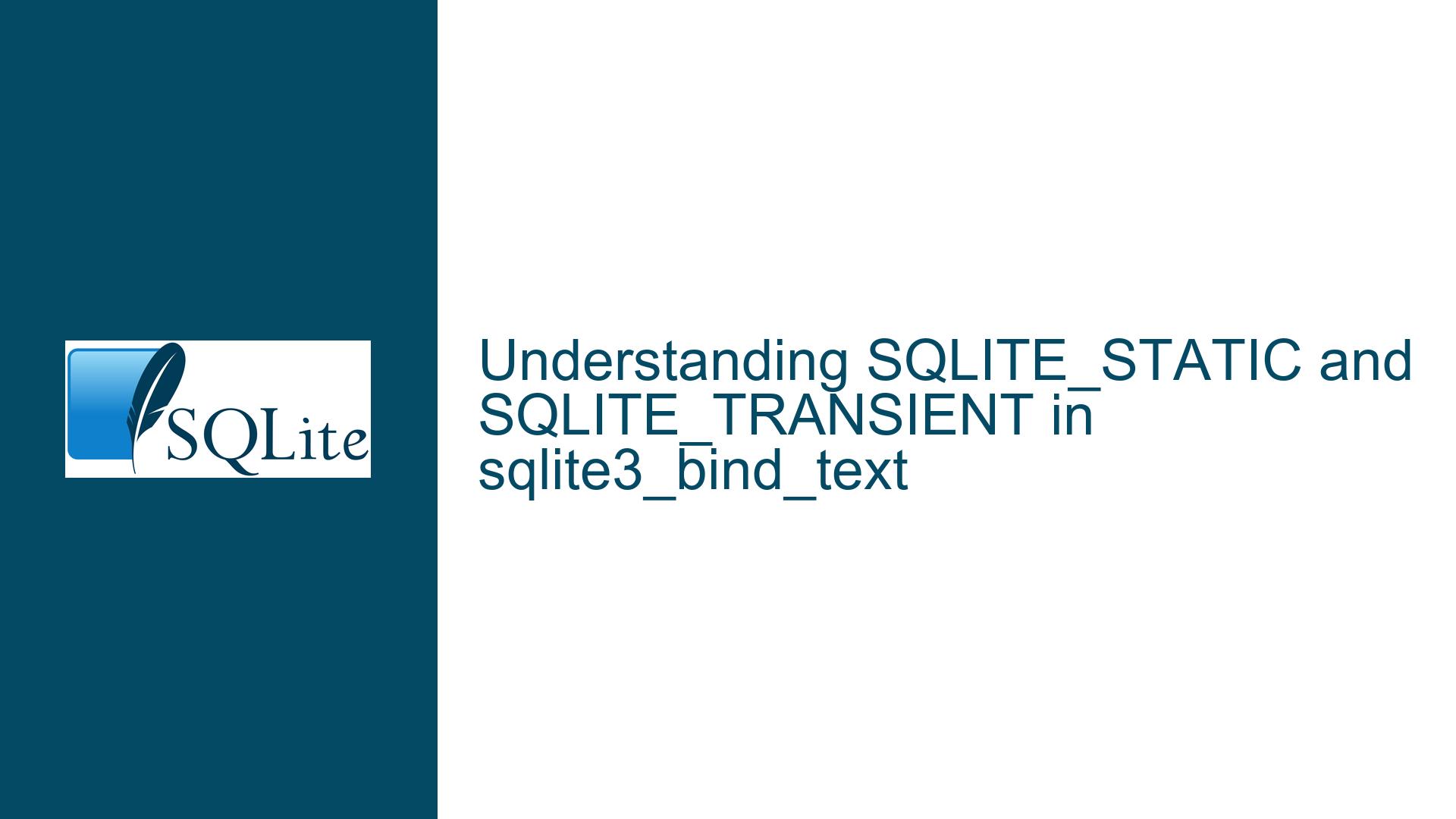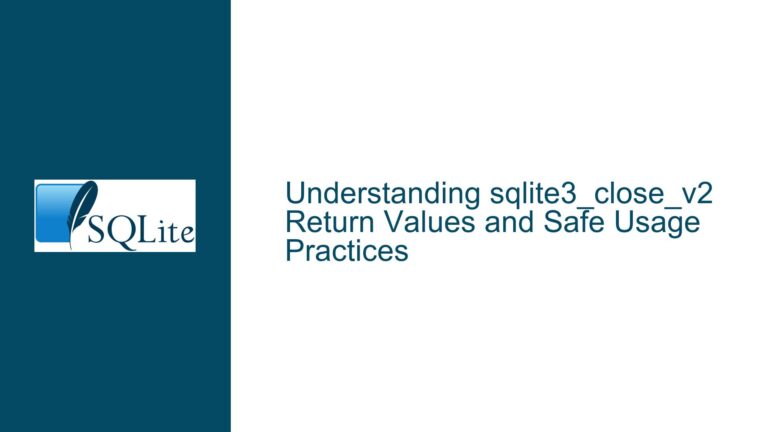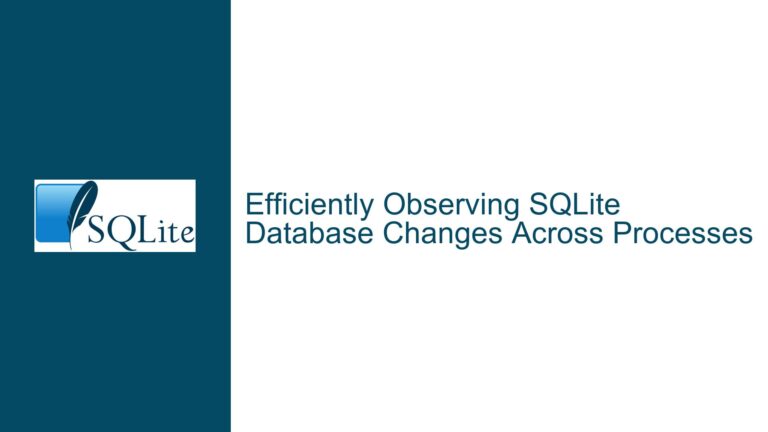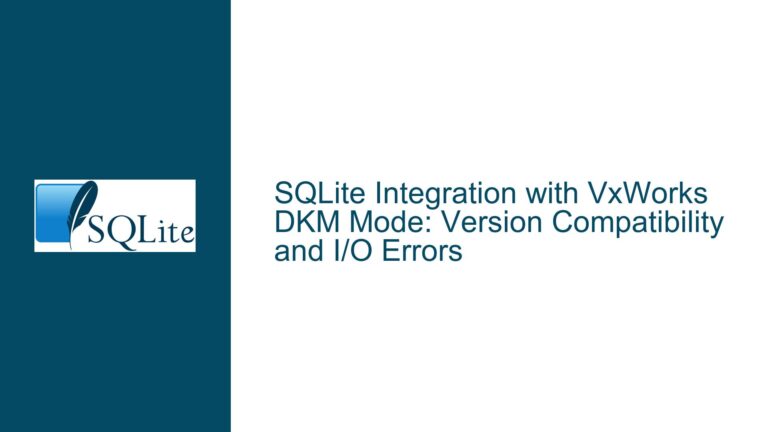SQLITE_STATIC and SQLITE_TRANSIENT in sqlite3_bind_text
Memory Management in sqlite3_bind_text: SQLITE_STATIC vs. SQLITE_TRANSIENT
When working with SQLite in C, one of the most critical aspects of binding text data to prepared statements is understanding the implications of memory management. The sqlite3_bind_text() function allows you to bind a text value to a placeholder in a prepared SQL statement. However, the behavior of this function can vary significantly depending on whether you use SQLITE_STATIC or SQLITE_TRANSIENT as the final argument. This choice determines how SQLite handles the memory associated with the text data you are binding.
SQLITE_STATIC: Assuring Memory Persistence
SQLITE_STATIC is used when you can guarantee that the memory pointed to by the text data will remain valid and unchanged for the entire duration that SQLite needs to access it. This typically means that the memory should not be freed or altered until after the prepared statement is finalized. When you use SQLITE_STATIC, SQLite assumes that the text data will remain accessible and unmodified, and thus, it does not make a copy of the data. This can lead to performance improvements, especially when dealing with large strings, as it avoids the overhead of memory allocation and copying.
However, using SQLITE_STATIC comes with risks. If the application frees or modifies the memory before SQLite has finished using it, the behavior is undefined. This could lead to crashes, data corruption, or other unpredictable outcomes. Therefore, SQLITE_STATIC should only be used when you are absolutely certain that the memory will remain valid for the entire duration of the prepared statement’s execution.
SQLITE_TRANSIENT: Ensuring Data Safety
On the other hand, SQLITE_TRANSIENT is used when you cannot guarantee the longevity or immutability of the memory pointed to by the text data. When you use SQLITE_TRANSIENT, SQLite makes its own copy of the text data immediately. This means that the application is free to modify or free the original memory as soon as the sqlite3_bind_text() function returns. SQLite will manage the copied data internally, ensuring that it remains accessible for as long as needed.
Using SQLITE_TRANSIENT is always safe, as it eliminates the risk of SQLite accessing invalid or modified memory. However, it does come with a performance cost, as it involves additional memory allocation and copying. For small strings or infrequent operations, this overhead is usually negligible. But for large strings or high-frequency operations, the performance impact can become significant.
Choosing Between SQLITE_STATIC and SQLITE_TRANSIENT
The choice between SQLITE_STATIC and SQLITE_TRANSIENT should be guided by the following considerations:
Memory Management Guarantees: If you can guarantee that the memory will remain valid and unmodified for the entire duration of the prepared statement’s execution,
SQLITE_STATICcan be used to avoid unnecessary memory copying. However, if you cannot provide such guarantees,SQLITE_TRANSIENTis the safer choice.Performance Considerations: If performance is a critical concern and you are dealing with large strings or high-frequency operations,
SQLITE_STATICcan offer performance benefits by avoiding memory copying. However, this should only be done after thorough testing to ensure that the memory remains valid throughout the statement’s execution.Development Stage: During the development and testing phase, it is often advisable to use
SQLITE_TRANSIENTto avoid potential memory-related bugs. Once the application is stable and you have a clear understanding of the memory lifecycle, you can consider switching toSQLITE_STATICfor performance optimization.
Memory Allocation Strategies and SQLite’s Handling of Bound Values
When using prepared statements with placeholders (denoted by ?), SQLite handles the memory allocation for the bound values internally. This means that you do not need to pre-allocate memory for the values that will be bound to the placeholders. SQLite will manage the memory for the bound values, ensuring that they are stored and accessed correctly during the execution of the prepared statement.
Memory Allocation for Bound Values
SQLite’s internal memory management for bound values is designed to be efficient and transparent to the application. When you bind a value to a placeholder using sqlite3_bind_text(), SQLite will allocate the necessary memory to store the value. The amount of memory allocated depends on the size of the value being bound. If you use SQLITE_TRANSIENT, SQLite will make a copy of the value, and the allocated memory will be managed internally until the prepared statement is finalized.
If you use SQLITE_STATIC, SQLite will not make a copy of the value, and it will rely on the application to ensure that the memory remains valid. In this case, SQLite will not allocate additional memory for the value, but it will still manage the memory associated with the prepared statement itself.
Reusing Memory for Bound Values
One common optimization strategy is to allocate a block of memory once and reuse it for multiple bound values. This can reduce the overhead of frequent memory allocation and deallocation. However, when reusing memory, it is crucial to ensure that the memory is not modified or freed while SQLite is still using it.
If you are reusing memory for bound values, you should use SQLITE_STATIC only if you can guarantee that the memory will remain valid for the entire duration of the prepared statement’s execution. If you cannot provide this guarantee, you should use SQLITE_TRANSIENT to ensure that SQLite makes its own copy of the value.
Clearing Bindings and Resetting Statements
After executing a prepared statement, it is often necessary to reset the statement and clear any bound values before reusing it. SQLite provides the sqlite3_reset() function to reset a prepared statement and the sqlite3_clear_bindings() function to clear all bound values.
When you reset a prepared statement, SQLite releases any internal resources associated with the statement, but it does not automatically clear the bound values. If you plan to reuse the statement with new bound values, you should call sqlite3_clear_bindings() to ensure that any previous bound values are cleared. This is particularly important if you are using SQLITE_STATIC, as it ensures that SQLite no longer holds references to the previously bound memory.
Best Practices for Using sqlite3_bind_text with SQLITE_STATIC and SQLITE_TRANSIENT
To ensure safe and efficient use of sqlite3_bind_text() with SQLITE_STATIC and SQLITE_TRANSIENT, consider the following best practices:
Start with SQLITE_TRANSIENT
During the initial development and testing phase, it is advisable to use SQLITE_TRANSIENT for all text bindings. This ensures that SQLite makes its own copy of the text data, eliminating the risk of memory-related bugs. Once the application is stable and you have a clear understanding of the memory lifecycle, you can consider switching to SQLITE_STATIC for performance optimization.
Profile and Optimize
If you find that memory copying is a performance bottleneck, profile your application to identify hotspots. If memcpy() operations are consuming a significant amount of time, consider switching some SQLITE_TRANSIENT bindings to SQLITE_STATIC. However, only do this after thorough testing to ensure that the memory remains valid throughout the statement’s execution.
Guarantee Memory Validity
If you choose to use SQLITE_STATIC, you must guarantee that the memory pointed to by the text data remains valid and unmodified for the entire duration of the prepared statement’s execution. This typically means that the memory should not be freed or altered until after the prepared statement is finalized.
Clear Bindings After Reset
When reusing a prepared statement, always call sqlite3_clear_bindings() after resetting the statement with sqlite3_reset(). This ensures that any previous bound values are cleared, preventing SQLite from holding references to invalid memory.
Use NULL Bindings When Necessary
If you need to clear a specific bound value, you can bind NULL to the placeholder using sqlite3_bind_null(). This is useful when you want to ensure that SQLite no longer holds a reference to a previously bound value.
Document Memory Management
When using SQLITE_STATIC, document the memory management strategy clearly in your code. This helps other developers understand the guarantees you are providing and reduces the risk of introducing memory-related bugs in the future.
Conclusion
Understanding the differences between SQLITE_STATIC and SQLITE_TRANSIENT is crucial for safe and efficient use of sqlite3_bind_text() in SQLite. While SQLITE_STATIC can offer performance benefits by avoiding memory copying, it requires careful management of memory to ensure that the data remains valid throughout the prepared statement’s execution. On the other hand, SQLITE_TRANSIENT is always safe, as it ensures that SQLite makes its own copy of the data, but it comes with a performance cost.
By following best practices, such as starting with SQLITE_TRANSIENT, profiling and optimizing, guaranteeing memory validity, and clearing bindings after reset, you can ensure that your application is both safe and efficient when using sqlite3_bind_text() with SQLite.






